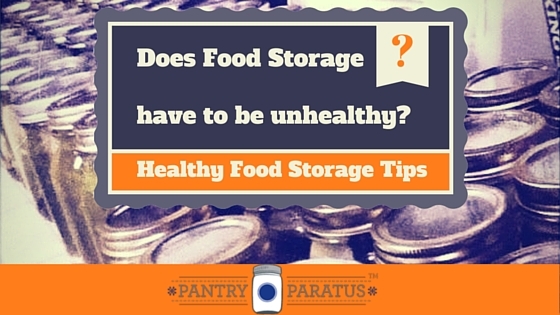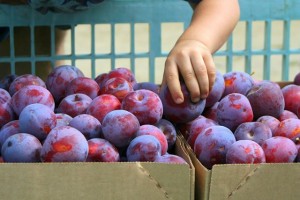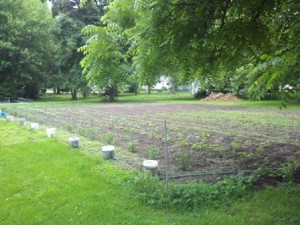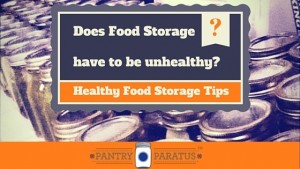
Food Storage. Healthy Eating.
People are sometimes surprised at how Pantry Paratus emphasizes both things, being under the misconception that a full pantry and a healthy one are paradoxical. I’m going to prove that wrong, and teach you how to switch to healthy food storage.
Why Food Storage Seems Unhealthy
This is how it is often done. Over the years of running expo booths at preparedness shows, I have witnessed a lot of crap being passed off for survival food at the surrounding tables. People often want something in boxes with an expiration date 5-10 years out (or longer!).
Sold! Write the check, load it up, done.
This is not being prepared for anything, and certainly not for the health consequences that might come from eating that stuff in a theoretical day when medical care is unavailable. What happens when that food runs out? Did that checkbox-checker learn any valuable skills, like baking bread when there is an egg shortage or making cheese from whatever milk is available—goat, sheep, or cow? If those skills aren’t routinely practiced, I daresay that they haven’t been learned at all. Any skill has a multitude of variables that will come into play during a worst-case scenario.
If you don’t routinely practice preparedness skills during good times, you won’t have a clue in an emergency.
If boxed and prepackaged food is your idea of a survival pantry, then you’re right—a prepared pantry and a healthy pantry are indeed juxtaposed.
Conversely, if your idea of a healthy meal requires a daily jaunt to the local health food store, where you buy only fresh organic fruits, vegetables, and some kind of congealed soy byproduct passed off as yogurt…then a prepared pantry and a “healthy” one are again at odds.
The Truth about a Prepared & Healthy Pantry
We were probably our healthiest at our poorest. Wilson left a mid-range six figure income and we moved across the country to pursue our dreams of living off the land and starting Pantry Paratus. Okay, there would have been smarter ways to do that, in hindsight.
If I didn’t grow it or barter for it, we didn’t eat it. A friend would offer out fruit from their tree, and then I’d trade jam for deer meat with someone else. We would trade our butchering services for nasty, tough goat meat. Okay, there would have been smarter ways to barter, in hindsight.
“Lord, if it ain’t dead, kill it. Amen.”
My point is that we grew or bartered much of what we ate, and we ate a lot out of our food storage. We had energy, we felt great. Here was the trick: we were eating traditional foods. We eat bulk grain such rice, quinoa, wheat. We eat fermented foods like kefir and homemade sauerkraut. We eat fresh fruits (from the neighbor’s apple tree, bartered plums, local berries) and we eat home-preserved ones, too (dehydrated peaches from the orchard one state over, banana chips, fruit leathers, pear sauce and pear rings).

We dig up our own vegetables or seek local sources (I just can never grow enough of my own tomatoes no matter how hard I try). Again, we eat those fresh or preserved (like our “sun dried tomatoes” or zucchini chips).

When you start with fresh foods, the food brings it’s own flavor and you can be a minimalist with spices. There is no need for preservatives or chemicals to mask or enhance flavors or colors. There is no need for over-processing or heating. You let the food be the star of the show. It’s delicious, healthy, and…easily preserved to stock your pantry for a rainy day.
Both Cheaper: Healthy Food & Food Storage
Shop from your own pantry. Today, I found one last jar of dehydrated strawberries tucked in the very back. Ah, not quite strawberry season in our neck of the woods, but getting close! Do you know:
- how much strawberries cost right now in the grocery store,
- what types of pesticides were used on those,
- and what unethical practices were used in those Mexican strawberry fields?
I am saving money, providing a far-healthier alternative to my family, and am living our my personal ethics…all by taking an hour last spring to slice and dehydrate my strawberry surplus.
What is an hour worth to you? I guarantee, if you took a trip to the store to buy those strawberries, you’re not only spending more time in the long run than I took to preserve my own, you are spending much more money (between the gas and other purchases).
Garden, use the farmer’s market, and local food co-ops.
No, healthy food is not cheaper if you are buying prepacked healthy foods—the organic burrito or the organic animal-shaped crackers. If you stick to growing your own on what you can, buying what you can from local sources, and supplementing the rest…if you can make your own “prepackaged foods” (foil-wrapped burritos in your freezer, for instance), you will save money.
Why Pantry Paratus is committed to both a Healthy Pantry and a Prepared Pantry
If I have a storage area full of emergency food but suffer from diabetes, chronic fatigue, or any other potentially food-related sickness, I will not have the strength to be what I need to be in the time of an emergency. If I have nothing but the best foods available at a local health food store, I won’t have the cash left over to build up my supplies of necessary items for future emergencies. In either situation, I would not have learned the skills I need to know.
Build your skills and by doing so, you will watch your empty pantry shelves fill up with nutritious and satisfying meals. Learn those skills & get equipped for healthy food storage at Pantry Paratus.



I am grateful to have found your site BUT I am so overwhelmed!!! I believe in preparedness but my hubby does not. I save ,he spends etc…where can I begin? What do I need to learn first? Or should learn first? We have 60 acres. I raise meat sheep. 30 of the 60 are woods with ponds. But I have no clue how to can and Im afraid of it!!! I have some possibly ucky emergency food prepared…but the OLD TIMEY SKILLS Nada!!!
Where does one start ?
Wow, you’re in a good situation for learning self-sufficiency, but you need to learn this first: one person cannot do it all. Just can’t. But you can do something. Even the smallest acts of preparedness will be appreciated in lean times. We all get overwhelmed when starting; just decide to pick one skill and try it. Don’t worry about learning everything at once. I would suggest the book, Woodland Homestead, for your particular situation, though. It’s going to help a lot with both land management and with preparedness, and might be a great way to ease your husband into the process.
There are so many things one can do to practice preparedness without it necessarily “reeking” of preparedness. Raising sheep, for example. Acres of woods (firewood). A vegetable garden, some fruit trees. Learning how to can (water bath and pressure) is not just a valuable skill, it’s a DELICIOUS skill.
That said, if you have a well, the pump is electric (at least ours is). Adding a manual pump (SimplePump is high on our list) means everyone – 2 and 4-legged – has water in the event of a natural disaster. Barring that, a generator that can run your well pump (also on our list), but even a generator to run your freezer from a few hours a day. If you don’t have wood heat (even as supplemental heat), some means heating A room in the event of a cold weather power outage.
Depending on where you live, the situations you may encounter will be different, but just a few local ones…
A few years back we had 2 major windstorms back-to-back and the power was out for nearly 2 weeks. We didn’t have enough water stored for us (2 adults, 1 small dog) and our goats, sheep, and chickens. Thankfully, we were able to fill our containers (and our neighbor’s) at a service station 10 minutes drive. We had a full pantry and we heat exclusively with wood, and had a generator to keep our freezer frozen. Our neighbors had enough food, but no alternative heat and no generator. They borrowed our generator at night to run a space heater and keep their freezer frozen, and we brought them hot coffee (made on our woodstove) in the morning when we hauled it back to run our freezer. They have a generator now 😉
Several years before that there was a major ice storm. Damages aside, shelves went unstocked because the delivery trucks couldn’t get to the stores.
We’ve had snow storms that have had roads undrivable, people snowed in, store roofs collapsed, etc.
Preparedness can be done frugally or no-expense-spared. It can look completely sane or totally looney-toons. Mix and match.
When you take on pressure canning (I prefer a weighed gauge to a dial gauge), cut your lamb into stew chunks, brown in small batches, and can it up. Even the most mature ram is DELICIOUS.